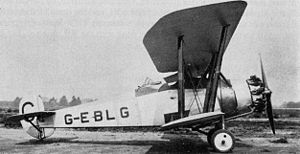
Summary
The Bristol Boarhound was a British army cooperation and liaison aircraft of the 1920s. It was a two-seat biplane with wings of equal span and a steel frame construction with fabric covering.
| Boarhound | |
|---|---|

| |
| Boarhound I | |
| Role | Army co-operation |
| Manufacturer | Bristol |
| Designer | Frank Barnwell |
| First flight | 8 June 1925 |
| Introduction | 1928 |
| Primary user | Mexico |
| Number built | 4 |
Design and development edit
The Boarhound was built as a private venture under Air Ministry Specification 8/24 (later superseded by Specification 20/25) for an Army cooperation aircraft to replace the Bristol Fighter, first flying on 8 June 1925[1] as the Type 93 Boarhound.
The Boarhound, designed by Captain Frank Barnwell, was a two-bay biplane which used a method of steel construction which involved high-tensile steel strips rolled into cusped and flanged sections, which were riveted together to form longerons and struts. The resulting structure was lighter, stronger, and cheaper than one made from drawn tubes. It had a deep fuselage allowing bulky radio and camera equipment to be carried,[2] and was powered by a Bristol Jupiter IV engine with variable timing.
The Boarhound was evaluated alongside the Armstrong Whitworth Atlas, de Havilland Hyena and Vickers Vespa. The Jupiter's variable timing gear gave poorer power at low altitudes, a disadvantage for an army cooperation aircraft, and the Atlas was considered superior.[2]
The Directors of Bristol decided, however, to continue development of the aircraft as a private venture for a general-purpose bomber to replace the Airco DH.9A. A second aircraft was therefore built, the Type 93A Beaver, which flew on 23 February 1927. This was rejected in favour of the Fairey IIIF, which used the preferred Napier Lion engine, of which large numbers were in store.
The Boarhound I (registered G-EBLG) and the Beaver (registered G-EBQF) were withdrawn from use at Filton Aerodrome in April 1927.[3]
A further two aircraft were produced as reconnaissance fighters as the Type 93B Boarhound II.[2]
Operational history edit
The only two Boarhound IIs ever built were sold to Mexico in 1928 and were used against rebel forces in April 1929.[2] The Boarhounds proved successful in Mexican service, their metal structure proving suitable for the climate. Two legends of the Mexican Air Force flew the Boarhound II: Pablo Sidar and Alfonso Cruz Rivera.
Variants edit
- Type 93 Boarhound
- Army cooperation aircraft, powered by a Jupiter IV engine. One built
- Type 93A Beaver
- General-purpose aircraft. One built.
- Type 93B Boarhound II
- Fighter-reconnaissance aircraft for Mexico, powered by 450 hp (340 kW) Jupiter VI engine. Two built.
Operators edit
Specifications (Boarhound I) edit
Data from Bristol Aircraft Since 1910 [2]
General characteristics
- Crew: 2
- Length: 31 ft 6 in (9.60 m)
- Wingspan: 44 ft 9 in (13.64 m)
- Height: 11 ft 8 in (3.56 m)
- Wing area: 464 sq ft (43.1 m2)
- Empty weight: 2,900 lb (1,315 kg)
- Gross weight: 4,460 lb (2,023 kg)
- Powerplant: 1 × Bristol Jupiter IV 9-cylinder air-cooled radial piston engine, 425 hp (317 kW)
- Propellers: 2-bladed fixed-pitch propeller
Performance
- Maximum speed: 137 mph (220 km/h, 119 kn)
- Endurance: 3 hours
- Service ceiling: 22,000 ft (6,700 m)
- Time to altitude: 10,000 ft (3,048 m) in 10 minutes 38 seconds[1]
- Wing loading: 9.61 lb/sq ft (46.9 kg/m2)
- Power/mass: 0.095 hp/lb (0.156 kW/kg)
Armament
- Guns:
- 1 × forward-firing .303 in (7.7 mm) Vickers machine gun on side of fuselage
- 1 × .303 in (7.7 mm) Lewis Gun on Scarff ring (observer)
- Bombs:
- 2 × 112 lb (50 kg) bombs
See also edit
Aircraft of comparable role, configuration, and era
- Aero A.32
- Armstrong Whitworth Atlas
- de Havilland Hound
- de Havilland Hyena
- Fairey IIIF
- Fairey Ferret
- Gloster Goral
- Potez 25
- Short Shamois
- Vickers Vespa
- Vickers Valiant
- Vickers Vixen
- Westland Wapiti
Notes edit
- ^ a b Mason, Francis K (1994). The British Bomber since 1914. London: Putnam Aeronautical Books. ISBN 0-85177-861-5.
- ^ a b c d e Barnes, C.H. (1964). Bristol Aircraft Since 1910 (First ed.). London: Putnam.
- ^ Jackson, A.J. (1973). British Civil Aircraft since 1919 (Volume I) (Second ed.). London: Putnam. ISBN 0-370-10006-9.
References edit
- Donald, David, and Lake, Jon, eds. Encyclopedia of World Military Aircraft. London: AIRtime Publishing, 1996. ISBN 1-880588-24-2.
External links edit
- Bristol Boarhound – British Aircraft Directory
- The Transport Archive – Bristol Boarhound


